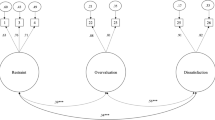Abstract
Objective: To evaluate the Swedish version of the Eating Disorder Inventory (EDI-C) for the internal consistency, factor structure and ability to discriminate between adolescent girls with and without a known eating disorder (ED). Methods: Completely answered EDI-C questionnaires were available from 201 girls diagnosed with an ED and from 2073 schoolgirls. The girls were adolescents attending grade 7–12. Results: Internal consistency was 0.70–0.91 for the ED group. Eleven factors with eigenvalue >2.2 explained 56% of the variance and showed satisfying correspondence to the proposed constructs of EDI-C. A discriminant analysis classified 85.6% of the cases correctly. The three most important discriminating subscales were Drive for Thinness, Asceticism and Body Dissatisfaction. All subscales except Maturity Fears showed significantly higher mean values for the ED group. Conclusions: The results indicate that the psychometric properties of EDI-C are comparable to the properties of EDI-2. EDI-C should be preferred for adolescents since its statements suit this age group.
Similar content being viewed by others
References
Garner D.M.: The Eating Disorder Inventory-2. Professional manual. Odessa, FL, Psychological Assessment Resources, Inc., 1991a.
Garner D.M.: The Eating Disorder Inventory-C. Lutz, FL, Psychological Assessment Resources (PAR), 1991b.
Norring C., Sohlberg S.: Eating Disorder Inventory in Sweden: description, cross-cultural comparison, and clinical utility. Acta Psychiatr. Scand., 78, 567–575, 1988.
Nevonen L., Broberg A.: Validating the Eating Disorder Inventory-2 (EDI-2) in Sweden. Eat. Weight Disord., 6, 59–67, 2001.
Edlund B., Halvarsson K., Gebre-Medhin M., Sjödén PO.: Psychological correlates of dieting in Swedish adolescents: A cross-sectional study. Eur. Eat. Disord. Rev., 7, 47–61, 1999.
Edlund B., Hallqvist G., Sjödén P-O.: Attitudes to food, eating and dieting in 11 and 14-year old Swedish children. Acta Paediatr., 83, 572–577, 1994.
Edlund B., Halvarsson K., Sjödén, P.-O.: Eating behaviour, and attitudes to eating, dieting and body image in 7-year-old Swedish girls. Eur. Eat. Disord. Rev., 4, 40–53, 1996.
Engström I., Norring C.: Estimation of the population ”at risk” for eating disorders in a non-clinical Swedish sample: A repeated measure study. Eat. Weight Disord., 7, 45–52, 2002.
Råstam M.: Anorexia nervosa in 51 Swedish children and adolescents: Pre-morbid problems and comorbidity. J. Am. Acad. Child Adolesc. Psychiatry, 31, 819–829, 1992.
American Psychiatric Association: Diagnostic and Statistical Manual of Mental Disorders, 4th ed. Washington, DC, American Psychiatric Association, 1994.
Clinton D., Norring C.: The Rating of Anorexia and Bulimia (RAB) interview: Development and preliminary validation. Eur. Eat. Disord. Rev., 7, 362–371, 1999.
Walkey F.: Simple versus complex factor analyses of responses to multiple scale questionnaires. Multivariate Behavioural Research, 18, 401–421, 1983.
Jacobson N.S., Truax P.: Clinical significance: a statistical approach to define meaningful change in psychotherapy research. J. Consult. Clin. Psychol., 59, 12–19, 1991.
Rosen J.C., Silberg N.T., Gross, J.: Eating attitudes test and Eating Disorders Inventory: Norms for adolescent girls and boys. J. Consult. Clin. Psychol., 56, 305–308, 1988.
Shore R.A., Porter J.E.: Normative and reliability data for 11 to 18 year olds on the Eating Disorder Inventory. Int. J. Eat. Disord., 9, 201–207, 1990.
Welch G., Hall A., Norring C.: The Factor structure of the Eating Disorders Inventory in a patient setting. Int. J. Eat. Disord., 9, 79–85, 1990.
Eberenz K.P., Gleaves D.H.: An examination of the internal consistency and factor structure of the Eating Disorder Inventory-2 in a clinical sample. Int. J. Eat. Disord., 16, 371–379, 1994.
Welch G., Hall A., Walkey F.: The factor structure of the Eating Disorders Inventory. J. Clin. Psychol., 44, 51–56, 1988.
Shoemaker C., Verbraak M., Breteler R., van der Staak C.: The discriminant ability of the Eating Disorder Inventory-2. Br. J. Clin. Psychol., 36, 627–629, 1997.
Author information
Authors and Affiliations
Corresponding author
Rights and permissions
About this article
Cite this article
Thurfjell, B., Edlund, B., Arinell, H. et al. Psychometric properties of Eating Disorder Inventory for children (EDI-C) in Swedish girls with and without a known eating disorder. Eat Weight Disord 8, 296–303 (2003). https://doi.org/10.1007/BF03325029
Published:
Issue Date:
DOI: https://doi.org/10.1007/BF03325029




